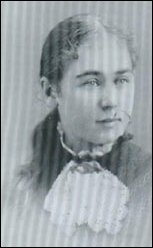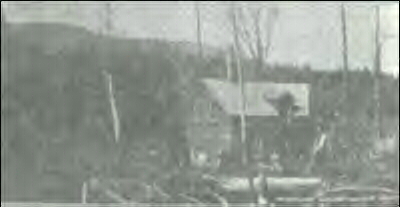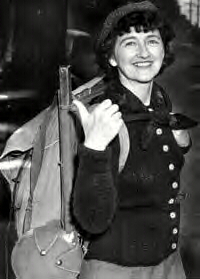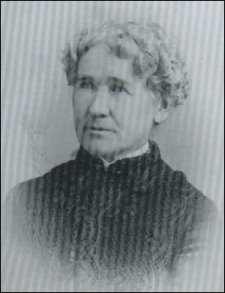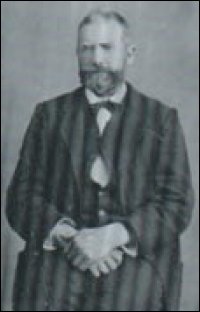Alger: at that time, the little village was actually called Lookout. Sometime by 1914 the town was named after the Alger Logging Co., owned by Russell Alger and Revaux K. Hawley, who logged the area until 1901. Read our 4-part series on Alger (Lookout) and its pioneers. We are moving all our original "stumpranchonline.com" features like this one to our new domain. This story will soon be changed to this address. If neither file connects, please email us.
|

|
Brosseau: the daughter she mentions here is Nina, the youngest Cook daughter, who was then living in Rockford, Illinois. Mr. Brosseau was Dwight Brosseau, whose pioneer parents, George and Edna, lived between Sterling and Sedro. His mother's lasting legacy was that she sewed the flag that waved from the top of a 200-foot fir on July 4, 1890, in Sedro as the two villages held dueling celebrations.
|

|
Fairie's death: Fairie Cook Litchfield died on Aug. 15, 1926, at her sister's home in Rockford. She was a widow.
|

|
Deputy Surveyor: that was Fred Hall, mentioned in Nina's diary above. He and his brother Woodbury homesteaded in the Prairie district, relatives of the Kallochs, for whom the road is named. The editor saw several affectionate letters in the family collection from Fred Hall to Fairie while she attended Wellesley College. She wound up marrying the father of her college roommate.
|

|
Girl friend: the girl was Louisa Anderson, a Swedish immigrant whose brother worked at Cook's shingle mill. She later married Joseph Hart, one of the four British bachelors who settled future Sedro.
|

|
Sections 7 and 12: the sections she refers to are in Township 36 North, Range 4 East. The town of Alger was in section 7, with the west fork of the Samish flowing nearby; the east fork flows through the east part of the township from section 12 down through Warner's Prairie. We suspect that Fairie found the claim with the help of Charles Warner, who logged Cook's timberlands.
|

|
Section 11: that section is about four miles east of the town of Alger and a half mile of what was then called Dry Creek. On the 1925 Metsker's map, that whole section is owned by David Tozer. We hope that a reader can identify who David Tozer was. His wife is listed as Julia Tozer and they owned large pieces of land all over the county. It may have been a relative of A.A. Tozer, the druggist partner of A.E. Holland in Sedro in the 1880s. Please email us if you know.
|

|
Years later: that would have been sometime after Fairie married Cyrenus Wirt Litchfield in Oak Park, Illinois, in December 1896, and sometime before Mortimer died on Nov. 22, 1899, in the Philippines.
|

|
Safe: there is a note of irony here. After he made a small fortune in Kansas, building the first iron bridge over the Kaw river, and after his second daughter died in a fire in Topeka, Cook moved his family to Santa Barbara in 1871. Los Angeles was barely a village and Santa Barbara was a market center on the California coast, but really just a smattering of buildings. Cook brought a safe to town and started a bank there, which became the first gold bank south of San Francisco, and his safe might have been the first one set up in southern California.
|

|
 Remember; we welcome correction & criticism. Remember; we welcome correction & criticism.
 Please report any broken links or files that do not open and we will send you the correct link. With more than 700 features, we depend on your report. Thank you. And do not give up if you find a link that seems to be closed. Just put the subject in the search box below. The story may have been moved to our new domain. Or just ask us and we will guide you to it. Please report any broken links or files that do not open and we will send you the correct link. With more than 700 features, we depend on your report. Thank you. And do not give up if you find a link that seems to be closed. Just put the subject in the search box below. The story may have been moved to our new domain. Or just ask us and we will guide you to it.
 Did you enjoy this story? Remember, as with all our features, this story is a draft and will evolve as we discover more information and photos. This process continues until we eventually compile a book about Northwest history. Can you help with copies or scans of documents or photos? We never ask for your originals. Did you enjoy this story? Remember, as with all our features, this story is a draft and will evolve as we discover more information and photos. This process continues until we eventually compile a book about Northwest history. Can you help with copies or scans of documents or photos? We never ask for your originals.
 Read about how you can order CDs that include our photo features from the first ten years of our Subscribers-paid online magazine. Perfect for gifts. Although it was delayed by our illness, it is due for completion in 2012. Read about how you can order CDs that include our photo features from the first ten years of our Subscribers-paid online magazine. Perfect for gifts. Although it was delayed by our illness, it is due for completion in 2012.
|
You can click the donation button to contribute to the rising costs of this site. See many examples of how you can aid our project and help us continue for another ten years. You can also subscribe to our optional Subscribers-Paid Journal magazine online, which celebrated its tenth anniversary in September 2010, with exclusive stories, in-depth research and photos that are shared with our subscribers first. You can go here to read the preview edition to see examples of our in-depth research or read how and why to subscribe.
|
|
You can read the history websites about our prime sponsors
Would you like information about how to join them in advertising?
 Our newest sponsor, Plumeria Bay, is based in Birdsview, just a short walk away from the Royal family's famous Stumpranch, and is your source for the finest down comforters, pillows, featherbeds andduvet covers and bed linens. Order directly from their website and learn more about this intriguing local business. Our newest sponsor, Plumeria Bay, is based in Birdsview, just a short walk away from the Royal family's famous Stumpranch, and is your source for the finest down comforters, pillows, featherbeds andduvet covers and bed linens. Order directly from their website and learn more about this intriguing local business.
 Oliver-Hammer Clothes Shop at 817 Metcalf Street in downtown Sedro-Woolley, 90 years continually in business. Oliver-Hammer Clothes Shop at 817 Metcalf Street in downtown Sedro-Woolley, 90 years continually in business.
 Peace and quiet at the Alpine RV Park, just north of Marblemount on Hwy 20, day, week or month, perfect for hunting or fishing. Park your RV or pitch a tent — for as little as $5 per night — by the Skagit River, just a short drive from Winthrop or Sedro-Woolley. Alpine is doubling in capacity for RVs and camping in 2011. Peace and quiet at the Alpine RV Park, just north of Marblemount on Hwy 20, day, week or month, perfect for hunting or fishing. Park your RV or pitch a tent — for as little as $5 per night — by the Skagit River, just a short drive from Winthrop or Sedro-Woolley. Alpine is doubling in capacity for RVs and camping in 2011.
 Joy's Sedro-Woolley Bakery-Cafe at 823 Metcalf Street in downtown Sedro-Woolley. Joy's Sedro-Woolley Bakery-Cafe at 823 Metcalf Street in downtown Sedro-Woolley.
 Check out Sedro-Woolley First section for links to all stories and reasons to shop here first Check out Sedro-Woolley First section for links to all stories and reasons to shop here first
or make this your destination on your visit or vacation.
 Are you looking to buy or sell a historic property, business or residence? Are you looking to buy or sell a historic property, business or residence?
We may be able to assist. Email us for details.
|

 810 Central Ave.,
810 Central Ave., 